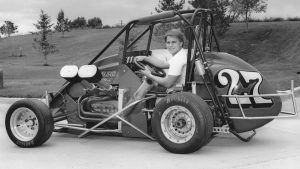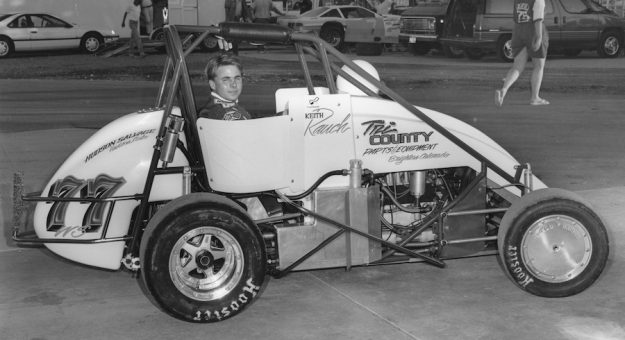Life circumstances have an annoying habit of derailing our dreams. This alone can be a source of irritation, but it is particularly distressing when we are impacted by forces outside our control.
It is a situation that can cause one to retreat and sulk or take the mature approach and make the most of opportunities at hand.
There was a time when those who excelled in midget racing beat a direct path to Indianapolis Motor Speedway. Those days are gone.
Make no mistake about it, in a different era Colorado’s Keith Rauch would have walked into Gasoline Alley and entertained offers from a range of suitors. Despite the odds that stared him directly in the face, decades ago Rauch could be excused for fantasizing about taking a swig of cold milk at the end of the 500-mile grind.
After all, when you are a young and successful open wheel driver it is too tempting of a thought to discard.
It was a notion even harder to shake when he received an unexpected call. On the other end of the line was Parnelli Jones offering him a chance to race a midget at Ventura (Calif.) Speedway. It was nearly surreal. Not only did Rauch jump at the chance, but he topped it off with a victory in a nationally-televised event.
That was a long time ago. Yet, this year, Rauch is still at it and has a chance to nail down his 14th Rocky Mountain Midget Racing Ass’n championship. If he completes the task, it will be 30 years since seizing his first title with the club.
It is a source of personal satisfaction and pride to have been the dominant racer in a proud organization for so many years. Any thoughts of cracking the starting field at the Brickyard faded many years ago. However, it turns out there was one tempting alternative within his grasp.
Rauch, midget racing and Indianapolis Motor Speedway intersect in a myriad of ways.
Rauch’s paternal grandparents Joe and Louise Rauch owned a small store and soda fountain in New Jersey during the Great Depression. Joe Rauch was a bit of a gearhead and he befriended and assisted midget racing standout “Little” Johnny Ritter.
Their son Ed, known in the family as Sonny, also became enamored with the sport. When asthma made life unbearable for Louise her doctors recommended that the family move west. The Rauches purchased the Primrose Motel in Denver and began a new life. Luckily, Lakeside Speedway, located in an amusement park in the Mile High City, was a midget racing hotbed.
By the mid-1950s Colorado racer Johnnie Tolan qualified for Indianapolis along with fellow midget racer and Pikes Peak Hill Climb winner Keith Andrews. The amiable Andrews was well-liked by fans and fellow competitors.
Andrews lived just doors away from Ed Rauch’s girlfriend and even bailed out the young man a time or two when he was short on gas money. He made an instant fan.
Andrews was at Indianapolis in 1957 hoping to start his third 500-mile race when he was asked to do a favor. Italian racer Emilio Giuseppe “Nino” Farina could not get his car up to speed and Andrews was asked to assess the problem. It would be the last laps he ever turned. At that bitter moment, Ed Rauch remembered a conversation he had with his hero.
He proclaimed that if he ever had a son, he would name him Keith.
Ed Rauch also suffered from asthma and it was suggested that he relocate to Phoenix. Starting a family in Arizona, he soon had son Keith under wing and the four-year-old took his first laps in a quarter midget at South Mountain Speedway. He was a natural talent.
Keith Rauch did well at home and traveled to Sacramento and Las Vegas to score significant national wins. Ed Rauch realized his offspring just might have a future in racing. As he matured, Rauch began working for owner Dave Ellis in his Phoenix shop, and when he turned 16, he could be found behind the wheel of a Volkswagen powered midget.

By the late 1980s, he had already been in victory lane and was developing a reputation as an up-and-comer. He later caught the eye of Denver-based owner Tony Finley. Finley would win the 1990 Chili Bowl Nationals with Pennsylvania’s John Heydenreich at the controls.
Satisfied as to what he saw, Finley asked Ed Rauch what it might take to lure his son to the Rocky Mountains.
“Probably an airline ticket,” Ed Rauch responded.
The wins and titles came in bunches. Rauch also proved to be proficient enough in sprint cars, commonly racing for his father-in-law the late Ernie DiCroce and Bill Staab’s Our Gang Motorsports. In 2004, he was the ASCS Rocky Mountain Region champion, but while he dabbled in sprint cars, midgets remained his first love.
It is a select few who can turn racing into a career. Rauch was in the majority. When he wasn’t racing, he toiled as a metal fabricator, a trade that continues to this day. Yes, he was largely a weekend warrior, albeit an extraordinarily successful one. There was no time for grandiose thinking or wasting energy pursuing elusive goals.
Then suddenly racing at the Indianapolis Motor Speedway was no longer just a pipe dream with a dirt track inside the venerable oval. Tempting though it was, it would still entail a long and expensive journey.
Rauch had raced at the second-generation 16th Street Speedway and elsewhere in Indiana, but suspected this would be an experience like no other. All it took was a little nudge and when his cousin and sometime car owner Todd Henry came back from his first trip to the BC39, Rauch heard enough to put this race on his bucket list.
“My cousin came back and said it was just such a cool atmosphere,” Rauch said. “He talked about what it was like to drive through the tunnel and actually being inside the speedway.”
The more Henry talked the more midget owner Patrick Bourke liked the idea. “Pat got the bug to do it,” Rauch said, “and when he got excited my teammate Jake Bubak said he wanted to go and I said I wanted to go, too.”
This isn’t just another racing trip. For Rauch, this sojourn is guided by a slightly different agenda. Rauch’s record reveals that he is used to winning. Accordingly, he’s headed east loaded for bear. However, as the entry list for the BC39 swells, and he ponders the quality of the equipment and competition at hand, he tempers his prospects.
When asked if he expects or hopes to crack the starting field on Saturday night, he is quick with his response.
“Hope would be the best word,” he said. “Obviously, a bunch of those guys race all the time and that just makes you better. We only run about twelve times a year now. That matters. So I don’t have real high expectations, but maybe the old guy can get in there with the kids.”
As odd as it sounds for a man who has been competitive his entire life this is one time where the process may be as important as the outcome. He’s going to let it all soak in while he drives through the tunnel. He’s also going to work in a round of golf on the grounds and spend time in the museum.
In short, he wants to do it all. This is a moment Keith Rauch has earned.
When Rauch thinks about competing at the Indianapolis Motor Speedway he says, “It’s big. It is just something I want to experience.”
In contrast, for many of the younger set, the BC39 is white-knuckle time.
It is a prestigious race with big money on the line. There are career goals to consider and the ever-present push to get to the next level. There is no next level for Keith Rauch. There is also no need to lament. He has enjoyed a Hall of Fame career doing what he does best. He has taken the baton from a host of Rocky Mountain midget legends and ran with it.
Yes, he has faithfully honored the memory of Keith Andrews and soon he will walk the same grounds that his namesake traversed more than 66 years ago. Better yet, he will be in position to proclaim that he is among the select few who have raced at Indianapolis Motor Speedway.
